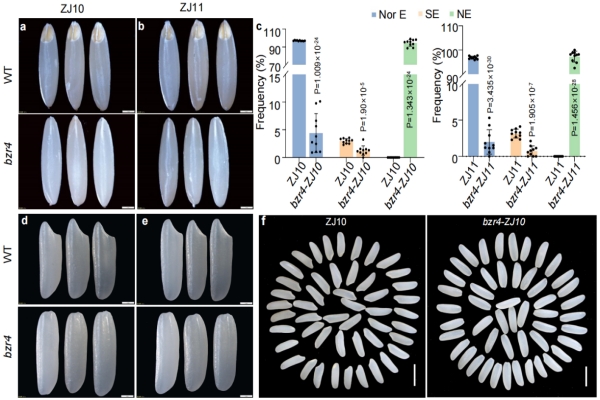Rice seed development critically influences both yield and quality. Within the seed, the embryo and endosperm fulfill distinct roles—propagation and nutrient storage, respectively—and their coordinated development is essential for seed viability. The embryoless mutant eml1 was first identified approximately three decades ago. Embryoless rice not only serves as a valuable model for investigating embryo and endosperm development, but its temperature-sensitive characteristic also presents potential for breeding applications. Nevertheless, the regulatory genes underlying the embryoless phenotype in rice remain unidentified to date.
Recently, a research team led by Professor Bu Qingyun from the Northeast Institute of Geography and Agroecology, Chinese Academy of Sciences, identified the regulatory gene OsBZR4 responsible for embryoless rice formation and elucidated its underlying molecular mechanism.
This work was published in Nature Communications on July 26.
This study establishes OsBZR4 as a key regulatory gene in embryoless rice formation. Mutations in OsBZR4 induce 60–100% embryoless seeds across diverse cultivars. The gene exhibits specific expression at the scutellum-endosperm interface. Mechanistically, OsBZR4 suppresses YUC4 and PIN5b expression, thereby modulating auxin levels and distribution during early seed development. Exogenous auxin application and YUC4 overexpression increase the embryoless frequency, whereas the auxin transport inhibitor N-1-naphthylphthalamic acid (NPA) reduces it. Additionally, higher temperatures increase the embryoless frequency in bzr4 mutant lines. Elevated temperature induces OsPIL13 expression, which promotes YUC4 transcription, thereby increasing auxin accumulation. This cascade elucidates the mechanism underlying temperature-dependent enhancement of the embryoless phenotype. Significantly, introducing the bzr4 mutant allele into elite cultivars (e.g., ZJ10 and ZJ11) improves both milled rice yield and grain storability.

Figure 1 eml mutants exhibit an embryoless phenotype.
In summary, targeted modulation of OsBZR4 enables the creation of thermosensitive embryoless rice varieties with enhanced energy reserves and improved storability. Building on these findings, future research will develop temperature-regulated embryoless germplasm. This material is designed to produce normal seeds for propagation under low temperatures while generating high proportions of embryoless seeds for food production under ambient or elevated temperatures, thereby advancing innovative rice production technologies.

Figure 2 A proposed working model for OsBZR4 in the regulation of embryogenesis.
Key words: Seeds Development; Embryoless seeds; Storability; rice
Contact:
Bu Qingyun
Northeast Institute of Geography and Agroecology, Chinese Academy of Sciences
Email: buqingyun@iga.ac.cn
Reference:
Zhenyu Wang#, Min Xu#, Yingxiang Liu, Xiaoming Zheng, Zhipeng Hong, Mingliang He, Xin Jin, Jiaqi Tang, Xiufeng Li, Xiaojie Tian, Qian Qian*, and Qingyun Bu*. OsBZR4 regulates temperature-dependent embryogenesis in rice. Nature Communications, 2025, 16: 6893.
https://doi.org/10.1038/s41467-025-62262-3